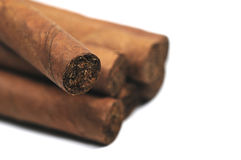Cigars, Cigarillos and Little Cigars

A cigar is defined "as a roll of tobacco wrapped in leaf tobacco or in a substance that contains tobacco, whereas a cigarette is defined as "any roll of tobacco wrapped in paper or in any substance not containing tobacco."1 Large traditional cigars contain at least one-half ounce of tobacco, which is as much as an entire pack of cigarettes, and takes one to two hours to smoke. The newest generation of cigars is very different from traditional cigars. A cigarillo is a short and narrow cigar that contains around three grams of tobacco and (usually) does not contain a filter. A little cigar is a small cigar that is close to the same size as a cigarette, and includes a filter. Little cigars and cigarillos are smoked in the same way as cigarettes. There is an emphasis on flavoring, small package sizes and low cost.2,3
Health Risks
Cigar use results in the same health conditions as traditional cigarette use including heart disease, cancer and lung disease. Cigars contain high levels of nicotine, making them addictive. Even if the cigar smoker does not inhale the nicotine, it is still absorbed through the lining of the mouth. Secondhand smoke exposure also results in adverse health such as lung cancer, respiratory disease, and even sudden infant death syndrome (SIDS) among babies.1
When you are ready to quit cigars, call 1-800-QUIT-NOW or visit: www.nevadatobaccoquitline.com
References
1. Centers for Disease Control and Prevention. Smoking and Tobacco Use: Cigars Fact Sheet.
3. National Cancer Institute. Cigar Smoking and Cancer Fact Sheet.
GetHealthy@nnph.org | 775-328-6160
Last modified on 08/15/2023
Let’s Stay in Touch
Sign up for our newsletter
